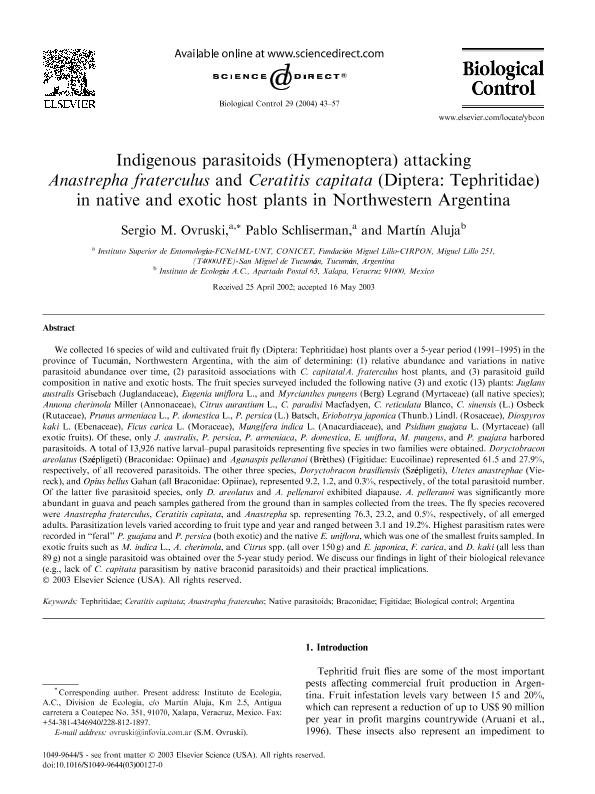Artículo
Indigenous parasitoids (Hymenoptera) attacking Anastrepha fraterculus and Ceratitis capitata (Diptera: Tephritidae) in native and exotic host plants in Northwestern Argentina
Fecha de publicación:
12/2004
Editorial:
Academic Press Inc Elsevier Science
Revista:
Biological Control
ISSN:
1049-9644
Idioma:
Inglés
Tipo de recurso:
Artículo publicado
Clasificación temática:
Resumen
We collected 16 species of wild and cultivated fruit fly (Diptera: Tephritidae) host plants over a 5-year period (1991-1995) in the province of Tucumán, Northwestern Argentina, with the aim of determining: (1) relative abundance and variations in native parasitoid abundance over time, (2) parasitoid associations with C. capitata/A. fraterculus host plants, and (3) parasitoid guild composition in native and exotic hosts. The fruit species surveyed included the following native (3) and exotic (13) plants: Juglans australis Grisebach (Juglandaceae), Eugenia uniflora L., and Myrcianthes pungens (Berg) Legrand (Myrtaceae) (all native species); Annona cherimola Miller (Annonaceae), Citrus aurantium L., C. paradisi Macfadyen, C. reticulata Blanco, C. sinensis (L.) Osbeck (Rutaceae), Prunus armeniaca L., P. domestica L., P. persica (L.) Batsch, Eriobotrya japonica (Thunb.) Lindl. (Rosaceae), Diospyros kaki L. (Ebenaceae), Ficus carica L. (Moraceae), Mangifera indica L. (Anacardiaceae), and Psidium guajava L. (Myrtaceae) (all exotic fruits). Of these, only J. australis, P. persica, P. armeniaca, P. domestica, E. uniflora, M. pungens, and P. guajava harbored parasitoids. A total of 13,926 native larval–pupal parasitoids representing five species in two families were obtained. Doryctobracon areolatus (Szépligeti) (Braconidae: Opiinae) and Aganaspis pelleranoi (Brèthes) (Figitidae: Eucoilinae) represented 61.5 and 27.9%, respectively, of all recovered parasitoids. The other three species, Doryctobracon brasiliensis (Szépligeti), Utetes anastrephae (Viereck), and Opius bellus Gahan (all Braconidae: Opiinae), represented 9.2, 1.2, and 0.3%, respectively, of the total parasitoid number. Of the latter five parasitoid species, only D. areolatus and A. pellenaroi exhibited diapause. A. pelleranoi was significantly more abundant in guava and peach samples gathered from the ground than in samples collected from the trees. The fly species recovered were Anastrepha fraterculus, Ceratitis capitata, and Anastrepha sp. representing 76.3, 23.2, and 0.5%, respectively, of all emerged adults. Parasitization levels varied according to fruit type and year and ranged between 3.1 and 19.2%. Highest parasitism rates were recorded in “feral” P. guajava and P. persica (both exotic) and the native E. uniflora, which was one of the smallest fruits sampled. In exotic fruits such as M. indica L., A. cherimola, and Citrus spp. (all over 150 g) and E. japonica, F. carica, and D. kaki (all less than 89 g) not a single parasitoid was obtained over the 5-year study period. We discuss our findings in light of their biological relevance (e.g., lack of C. capitata parasitism by native braconid parasitoids) and their practical implications.
Archivos asociados
Licencia
Identificadores
Colecciones
Articulos(PROIMI)
Articulos de PLANTA PILOTO DE PROC.IND.MICROBIOLOGICOS (I)
Articulos de PLANTA PILOTO DE PROC.IND.MICROBIOLOGICOS (I)
Citación
Ovruski Alderete, Sergio Marcelo; Schliserman, Pablo; Aluja, Martín; Indigenous parasitoids (Hymenoptera) attacking Anastrepha fraterculus and Ceratitis capitata (Diptera: Tephritidae) in native and exotic host plants in Northwestern Argentina; Academic Press Inc Elsevier Science; Biological Control; 29; 1; 12-2004; 43-57
Compartir
Altmétricas




